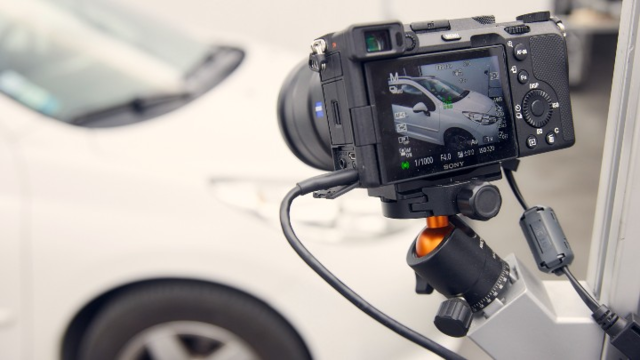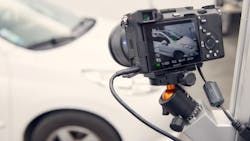AI Vehicle Inspection with Ultra-High-Resolution Cameras
In the rental industry, it can take on average 20 minutes to manually check a vehicle for exterior damage. When you consider the number of vehicles that need to be checked each day, it’s clear that such inspections can take a significant amount of time, ultimately slowing down a rental firm’s overall daily operations and costing it money.
However, recent technological developments mean these outdated, expensive, and time-consuming techniques can now be replaced with advanced automation processes, simultaneously improving performance, driving efficiency, and reducing costs.
Accurate Defect Detection
Recent advances in AI and machine learning technology mean automated vehicle solutions have become more commercially feasible in the last few years. In technical terms, this is largely because of a combination of lightweight multithreading—in which large numbers of cores are organized in groups to parallel process different workstreams—enabled by advances in graphical processing units (GPUs), with frameworks for convolutional neural networks (CNNs). These are commonly used to analyze visual imagery and provide access to cloud computing platforms that allow processing millions of images.
These technological advances allow companies to accurately detect defects on a vehicle and access the data in a matter of seconds. It means it’s now possible to inspect millions of vehicle images and accurately classify even the smallest of defects. Tiny dents, scratches, and chips that may once have been overlooked in a manual inspection can now be identified and displayed digitally in less than a minute.
For this process to be most effective, though, computers need to be able to see and interpret images as an array of pixels, meaning the resolution of those images is crucial in determining the accuracy of any defects detected. Image resolution, therefore, is critical. Given the contrast in highlights and shadows typically found on a reflective surface, such as that found on most cars today, a sensor with a wide dynamic range is needed to ensure images are of the highest possible quantity. Here, again, technical advances have made this possible.
Sony’s advanced, large format digital sensors, for example, have a much higher resolution and wider dynamic range than conventional machine vision cameras and can identify paint chips as small as just 1 mm in diameter and scratches as fine as a human hair. What’s more, large sensor sizes on the cameras mean a low level of image noise when the cars are moving.
Unlocking New Opportunities
Assessing damage to vehicles has, until recently, been a time-consuming and expensive manual process. But advances in AI and machine learning technology, coupled with powerful, high-resolution sensors, are set to change that, automating the process for greater efficiency, accuracy, and time savings. The technology, though, is still in a relatively nascent stage. Ongoing developments are set to unlock new opportunities in the years to come, and these aren’t only limited to the vehicle rental sector.
Automotive manufacturers, for instance, can deploy AI throughout the finished vehicle logistics chain. Automating inspections at the production plant and subsequently at every handover point until a vehicle arrives at a dealer will transform the process, combining improved accuracy with significant cost-saving opportunities.
Digitizing the entire process in this way, will provide an accurate record of a vehicle’s condition throughout its journey, from manufacturer to point of sale. Every partner in the chain will benefit from reliable, accurate, and consistent damage liability assignment, essential for identifying where process improvements can be made, and costs avoided. The automation enabled by AI will also allow for the redeployment of some, although certainly not all, human inspectors to more valuable functions within their business.
AI, augmented and supported by high-definition lenses with a wide dynamic range, has the potential to significantly disrupt the automotive industry for the better. The future of vehicle inspection lies in automation.
Introducing ALTO AI
ALTO AI, designed by French AI pioneers, Tchek, is a solution that allows manufacturers, insurers, and car dealers to identify and compare damage at speed, without the need for manual assistance. Using high resolution cameras, ALTO AI can seamlessly capture high-definition images and identify defects to millimeter precision. Importantly, cars will often need to be photographed at different times of day, in varying levels of light and types of weather. High-resolution cameras are vital in ensuring any defects are picked up, no matter the conditions. Working in combination with Tchek’s AI technology, these cameras will identify not only the fault, but also the severity of it. This combination—of powerful lenses and advanced AI—is essential in enabling business to process much larger volumes of vehicles at greater speed, and with extreme accuracy.
Tchek’s technology is designed to help organizations in the automotive industry to assess the exterior condition of a car at critical points throughout its ownership and usage journey. Its ALTO AI solution helps accelerate the vehicle inspection process by performing the task automatically, without any human intervention, in just a matter of seconds.
ALTO AI processes 360° imagery when a vehicle is checked out and again when it’s checked back in. The images are transferred to a separate server in which Tchek’s proprietary AI technology automatically compares the two sets of images to identify any damage that may have taken place during the vehicle’s usage, including type and severity, before transferring the results to the rental company’s own systems. In terms of the quality of imagery, Alto AI needs to to collect the maximum data to give an exact description of the vehicle’s damage. All of this depends on the extremely high-quality imagery provided by Sony’s Alpha 7C high resolution cameras, which are integrated into Tchek’s hardware solution. ALTO AI was designed and built-in collaboration with several different automotive businesses to address the needs of different sectors, from ex-factory to damage inspection for insurance and bodywork, remarketing or refurbishment, and rental. In the rental market, for instance, damage to vehicles can be quite significant, whereas in dealerships, it can be relatively minor. Tchek’s solution was created to identify the entire range of possible damage. Rental cars will often be photographed at varying times of the day, and in varying light and weather conditions. For ALTO AI to work successfully, the input imagery must be of outstanding quality so that the before and after images can be accurately compared.

Tchek also collaborated extensively with Sony on several key issues, such as identifying the best possible position to place the cameras within its hardware solution for maximum effectiveness. Sony also provided Tchek with a benchmark of the cameras at an early stage to illustrate the benefits of a large image sensor in its hardware solutions. Since then, Sony has regularly recommended key accessories and supported SDK programming to ensure its product remains stable, which is especially important in an unattended system such as ALTO AI. As it continues to develop its ALTO AI solution, Tchek expects its work with Sony will continue to grow, and that the introduction of new camera models in the future is expected to increase the speed and accuracy with which Tchek can analyze vehicles in conjunction with its AI technology.
About the Author
Yasuo Baba
Yasuo Baba is the director of Europe Digital Imaging at Sony Digital Imaging Europe.

